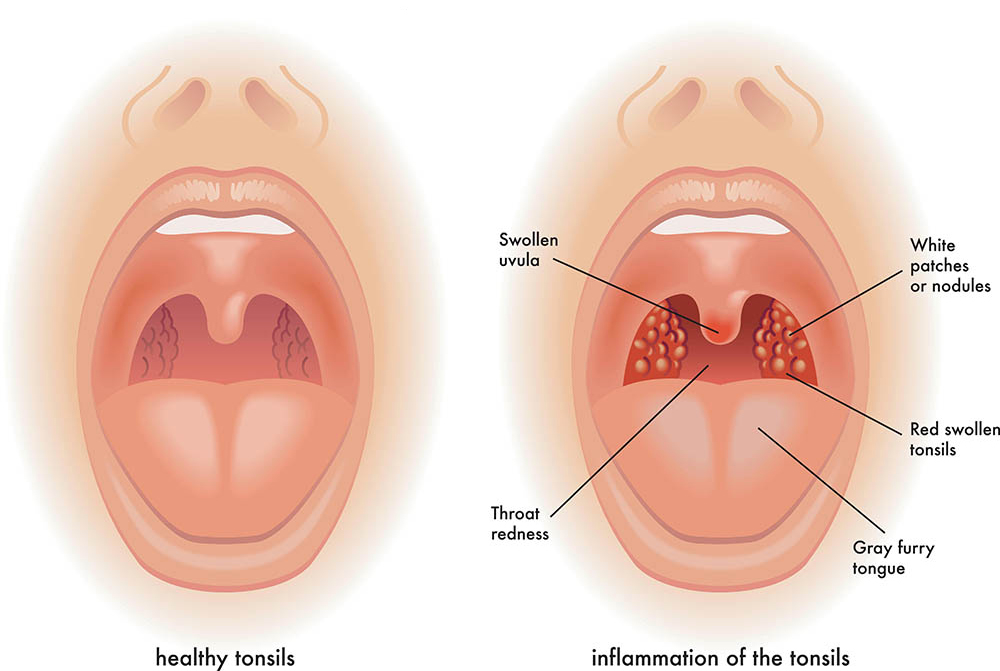The nurse is assessing the tonsils of an adult client. The nurse notices that the tonsils are involuted, granular in appearance, and has deep crypts. The nurse recognizes that which of the following is the correct response to these findings?
Continue with the assessment, looking for any other abnormal findings.
Refer the patient to a throat specialist.
No response is needed; this appearance is normal for the tonsils.
Obtain a throat culture on the patient for possible streptococcal (strep) infection.
The Correct Answer is A
A. Continue with the assessment, looking for any other abnormal findings: This is the correct response. Tonsils in adults can have various appearances, and a granular appearance with deep crypts is within the range of normal. It's essential for the nurse to continue the assessment and observe for other signs or symptoms that might indicate an issue.
B. Refer the patient to a throat specialist: Referring the patient based solely on the appearance of the tonsils, especially if it's a normal variant, might be unnecessary and could cause undue concern for the patient. It's important to assess the patient comprehensively before considering a specialist referral.
C. No response is needed; this appearance is normal for the tonsils: This is the correct explanation. In adults, tonsils often appear granular with deep crypts, which is considered a normal variation. No further action is required regarding the tonsils.
D. Obtain a throat culture on the patient for possible streptococcal (strep) infection: Based on the description provided (involution, granular appearance, and deep crypts), there's no specific indication of a streptococcal infection. Conducting a throat culture should be based on the presence of specific symptoms and signs indicative of a streptococcal infection, such as sore throat, fever, and swollen tonsils with white patches, rather than just the appearance of the tonsils.

Nursing Test Bank
Naxlex Comprehensive Predictor Exams
Related Questions
Correct Answer is ["B","C","D","E"]
Explanation
A. Age: While age itself is not modifiable, it is included in the list because aging increases the risk of developing cardiovascular disease. However, individuals cannot change their age, so it is not a modifiable risk factor.
B. Smoking: Smoking is a significant risk factor for cardiovascular disease. It damages the heart and blood vessels and can lead to atherosclerosis (narrowing and hardening of the arteries), which can result in heart attacks and strokes.
C. Hypertension: High blood pressure is a leading cause of cardiovascular disease. It can damage the arteries over time, making them more susceptible to atherosclerosis.
D. Diabetes: Diabetes, especially if poorly controlled, increases the risk of cardiovascular disease. High blood sugar levels can damage the blood vessels and the heart.
E. High cholesterol: Elevated levels of cholesterol, especially low-density lipoprotein (LDL) cholesterol, can lead to the buildup of plaque in the arteries, increasing the risk of atherosclerosis and cardiovascular events.
Correct Answer is B
Explanation
A. Simultaneously palpating both arteries to compare amplitude: While comparing amplitudes is important, using the diaphragm of the stethoscope to listen for bruits (abnormal whooshing sounds indicating turbulent blood flow) is a more specific and accurate method for assessing the carotid arteries for potential vascular issues.
B. Listening with the diaphragm of the stethoscope to assess for bruits: This technique allows the nurse to detect abnormal sounds (bruits) that could indicate partial blockages or stenosis in the carotid arteries, suggesting a risk of stroke or transient ischemic attack.
C. Instructing the patient to take slow deep breaths during auscultation: Deep breaths are more relevant during lung auscultation. Carotid artery assessment focuses on detecting abnormal sounds and assessing blood flow rather than respiratory patterns.
D. Palpating the artery at the base of the neck: Palpation alone does not provide enough information about potential blockages or abnormalities in the carotid arteries. Listening with a stethoscope allows for a more detailed assessment of blood flow and the presence of bruits.f the nurse hears a bruit during auscultation, they shouldnotpalpate the carotid artery. A bruit suggests partial obstruction (carotid stenosis), and compressing the artery further could worsen blood flow.
Whether you are a student looking to ace your exams or a practicing nurse seeking to enhance your expertise , our nursing education contents will empower you with the confidence and competence to make a difference in the lives of patients and become a respected leader in the healthcare field.
Visit Naxlex, invest in your future and unlock endless possibilities with our unparalleled nursing education contents today
Report Wrong Answer on the Current Question
Do you disagree with the answer? If yes, what is your expected answer? Explain.
Kindly be descriptive with the issue you are facing.
